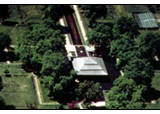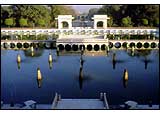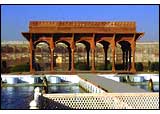 |
The Emperor Shah Jahan
Standing on a Globe
|
|
|
|
|
|
 |

Try
to imagine Shalamar garden as it was during Mughal times: a magnificent
royal stopping-place in the eastern suburbs of Lahore. In those
days travelers would approach the garden on foot or on horseback.
Even if one were in Lahore, it took many hours to get there. During
that time, the traveler would realize how closely Shalamar garden
was related to the Ravi River. The garden stood virtually alone
upon the riverbank. Its three broad terraces stepped majestically
down to the floodplain. A broad canal led from the river to the
garden, feeding hundreds of fountains, pools, and lushly irrigated
plantings. The surrounding landscape seemed flat, dry, and scrubby
in comparison.
|
 |
View
of a Kashmiri Garden


|
The waterworks
and terraces of Shalamar were unprecedented in Lahore. But gardens
in other regions like Kashmir helped to shape Shah Jahan's innovations
at Shalamar. Actually, there were five geographical sources of
inspiration for Shalamar: Central Asia, Kashmir, Western Punjab,
Persia, and the Delhi Sultanate.
|
|
|
Shah
Jahan was a boy when the first great Kashmiri gardens were built.
They far surpassed the gardens of Agra, Lahore, and Delhi for their
beauty, layout, and innovative uses of water. In building Shalamar,
Shah Jahan sought to bring Kashmir down to the plains. The three
terraces, the central water axis, and the marble waterfalls all
reflect the influence of Kashmir. And like Kashmir, the upper Ravi
River contained the ideal elements of Mughal garden design: a mountain
stream with sloping fields and shady forests. This is exactly what
the Mughals sought to recreate in gardens like Shalamar.

|
Middle
Terrace of
Shalamar Garden
|
 |
|
|
|
It is well
known that contemporary Mughal sources refer to Shalamar garden,
Lahore as Farah Bakhsh and Faiz Bakhsh (Baqir, 1984;
Latif, 1892; Kausar, Brand, and Wescoat, 1991). Construction of
the garden was ordered in 1641, as the Shah Nahr canal from the
Ravi River drew near Lahore (Begley and Desai, 1990, 277). The
garden officially opened in 1642.

"And
the gardens and the agreeable pavilions which had been erected
about the grounds, which all vied with the heavens in grandeur,
were now found suitable to the royal taste. In fact never before
had a garden of such magnificent description been seen or heard
of; for the buildings alone of this earthly Paradise had been
erected at an outlay of six lakhs of rupees" (ibid., 298).

Abdul Hamid Lahori described its dimensions in unusual detail,
especially given their irregular, non-decimal proportions which
bear no comparison with the layout of the Shahdara gardens.

|
The
Red Sandstone Pavilion
of Shalamar Garden
|
 |
|
|
Illuminated
Chinikhanas,
Detail from Lower Terrace
|
 |
|
|
|
Shalamar
is also the site of moving spiritual stories and poetry. One case
involved a prominent Sufi of the Qadriyya order, Inayat Khan,
and his pupil Bullhe Shah. Lajwanti Rama Krishna (1977, p. 42)
reports that Inayat Khan was the head gardener at Shalamar when
Bullhe Shah came to visit and displayed his magical prowess by
causing a mango to fall into his hands at his command. Unperturbed,
the head gardener Inayat Khan uttered the same command and all
of the mangoes fell to the ground; he uttered it again, and they
all returned to the trees. As an Arain gardener, Inayat Khan was
looked down upon by Bullhe Shah's family which reflects the low
social status traditionally accorded garden laborers vis-à-vis
garden builders (cf. Ibbetson, Maclagan, and Rose, 1978, v. 2,
13-16).

These stories remind us that, although historical texts situate
Shalamar for the most part within the dynastic chronicles of movement
and encampment, it was also a locus of intense spiritual and poetic
experience.
Conservation
Update: In Shalamar Bagh, the water
supply pipes on the lowest terrace are being changed, and new
flooring will be laid in the water channels. The flooring of the
water channel on the upper terrace is also being replaced. The
work of dismantling the existing floor is in progress. The brick
on-edge flooring on the eastern walkway of the upper terrace chahar
bagh is near completion. A new layer of clay was laid in the garden
and fresh grass was planted last year; now the garden is a lush
green. Another important contribution has been made in the eastern
quadrangle of Arz Begi: the structure was repaired and the paving
around the perimeter wall is now complete. The jharoka building
has also been repaired, and the apron around the jharoka is near
completion. It is expected that once the pavement is finished,
the lawns will be improved and a public entrance to the garden
will be opened from this side.

|
 |
 |
 |
 |
|